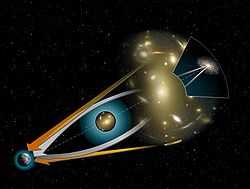B-modes

B-modes are a twisted pattern of polarized light that originated from the early universe billions of years ago. Its path got distorted by the gravitational lensing effect, that is, by the gravitational attraction of matter. Astronomers predict two types of B-modes. First that have formed recently some billion years ago, the age of universe is around 13.8 billion years. And the second kind of pattern originated with the birth of our universe following the Big Bang. These B-modes are called 'primordial'.
A research published Sep 30, 2013 in the online edition of Physical Review Letters, led by Duncan Hanson of McGill University in Montreal, Canada who is also the lead author, has discovered the B-modes using National Science Foundation's South Pole Telescope and with help from the Herschel space observatory. This discovery would open the possibilities of testing the theories of how our universe originated. Scientists are mining data from Planck mission to gauge better understanding of these waves. Planck mission is a European Space Agency mission in collaboration with NASA JPL where scientists work together to analyze the data. They are sifting through data to hunt the primordial form of these B-waves. [1] [2] [3]
References
- ↑ ESA Planck (Oct 22, 2013). "Planck Space Mission". Retrieved Oct 23, 2013.
- ↑ NASA/Jet Propulsion Laboratory (2013, October 22). "Long-sought pattern of ancient light detected". ScienceDaily. Retrieved October 23, 2013.
- ↑ Hanson, D.; S. Hoover, A. Crites, P. A. R. Ade, K. A. Aird, J. E. Austermann, J. A. Beall, A. N. Bender, B. A. Benson, L. E. Bleem, J. J. Bock, J. E. Carlstrom, C. L. Chang, H. C. Chiang, H-M. Cho, A. Conley, T. M. Crawford, T. de Haan, M. A. Dobbs, W. Everett, J. Gallicchio, J. Gao, E. M. George, N. W. Halverson, N. Harrington, J. W. Henning, G. C. Hilton, G. P. Holder, W. L. Holzapfel, J. D. Hrubes, N. Huang, J. Hubmayr, K. D. Irwin, R. Keisler, L. Knox, A. T. Lee, E. Leitch, D. Li, C. Liang, D. Luong-Van, G. Marsden, J. J. McMahon, J. Mehl, S. S. Meyer, L. Mocanu, T. E. Montroy, T. Natoli, J. P. Nibarger, V. Novosad, S. Padin, C. Pryke, C. L. Reichardt, J. E. Ruhl, B. R. Saliwanchik, J. T. Sayre, K. K. Schaffer, B. Schulz, G. Smecher, A. A. Stark, K. T. Story, C. Tucker, K. Vanderlinde, J. D. Vieira, M. P. Viero, G. Wang, V. Yefremenko, O. Zahn, M. Zemcov (Sep 30, 2013). "Detection of B-Mode Polarization in the Cosmic Microwave Background with Data from the South Pole Telescope". Physical Review Letters. 14 111. doi:10.1103/PhysRevLett.111.141301.
| ||||||||||||||||||||||||||||||||||||||||||||
